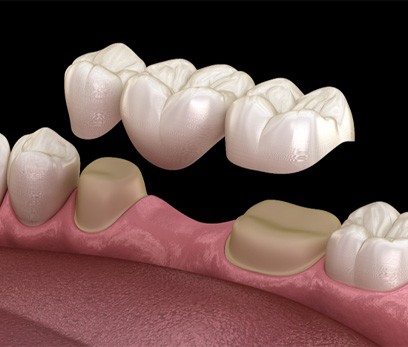
Dental Bridges – Delafield, WI
Bridging the Gap for Good

Dental bridges in Delafield are some of the most tried-and-true oral healthcare solutions available. At Bionica Dental Wellness of Delafield, our team of professionals is pleased to provide such service to individuals suffering from tooth loss. Because it can be so damaging to a person’s oral and overall health, it is uniquely effective at filling in the gaps, boosting confidence, and restoring function. If you are tired of the gaps and want to see a full, complete smile once again, call our office to schedule an appointment.
What is a Dental Bridge?

When you’re missing multiple teeth, you can rely on what is known as a dental bridge. Made from two dental crowns and artificial teeth (pontics), the crows sit on top of healthy abutment teeth that must be altered to hold the bridge in place. Between the crowns are pontics that mimic the look of natural teeth but rest on top of the gumline. Once bonded into place, these restorations make it easier to speak, eat, and smile so that you can continue to live with a more confident and positive attitude.
Types of Dental Bridges

Before you can receive a dental bridge, you must make an appointment with Dr. Holinbeck or another member of our team. It is during this visit that she will go over the various types of dental bridges you can choose from:
Traditional Dental Bridge
Traditional dental bridges are also referred to as fixed bridges because they are bonded into place over healthy teeth. These have been around for decades, giving people the chance to enjoy their smiles again.
Using traditional crowns and pontics to fill in the gaps, dental bridges are known for their stability and durability so that you can eat what you like, speak confidently, and feel completely at ease when conversing and smiling around others.
Implant Bridge
Instead of altering healthy teeth to serve as anchors for a traditional bridge, there is also the option of choosing implant bridges. Using two dental implant posts, we can place them within the jawbone on either side of the gap before placing a customized bridge over the top. Securing it into place, you will notice a dramatic difference in what your smile looks and feels like as well as how durable it is when eating and speaking. Not to mention, with proper care, these bridges can last a lifetime.
What Are the Benefits of Getting a Dental Bridge?

Some of the most prominent benefits you can expect with dental bridges include:
- The ability to enjoy a healthier smile either for a few years before replacement (traditional bridge) or for a lifetime (implant bridge)
- More confidence when opening your mouth to speak, smile, or eat
- Your healty teeth remain firmly and in place, avoiding future orthodontic work as well as dental drift
- Improved jawbone stimulation (implant bridge) that reduces the chances of facial collapse or sagging
Dental Bridge FAQs
How long should a dental bridge last?
Dental bridges are not designed to last forever, so the average timespan of a bridge is between 5-15 years. This can vary based on how well you take care of your new smile. Also, we must consider the type of material used to craft your bridge as well as where it is located inside your mouth. If placed toward the back, there is a greater chance you will need to have it replaced sooner simply because these are the teeth you chew with most often, so they suffer more wear and tear over time.
How many teeth can a dental bridge replace?
The important thing to remember is the longer the bridge, the less durable it is. Typically, a fixed bridge should replace no more than three or four teeth. Any more than that and the bridge will become highly vulnerable to possible breakage. Should you be missing more than four teeth, Dr. Holinbeck will likely recommend a partial denture instead, as this is better suited to treat nonconsecutive missing teeth in an arch as well as more extensive tooth loss.
You can expect that we will go over your available tooth replacement options with you during your initial consultation.
Do dental bridges look natural?
Yes, you can expect that your dental bridge will look and feel completely natural once put into place. Our team works closely with lab technicians to ensure that your new teeth look the same as your existing smile, allowing it to blend in seamlessly. Also, we make sure that it feels comfortable when placed inside your mouth. Although it might take a short amount of time to get used to the new fixture, you should be able to resume normal activity quite quickly.
In fact, you may discover that over the years, you have a hard time determining which teeth are real and which ones are artificial.
How do I clean under my bridge?
There are a few essential steps that must be followed if you want to keep your bridge clean and long-lasting. The process might seem tedious, but it is necessary. These include:
- Using floss to clean underneath your bridge, as it will help to remove bacteria.
- Using an interdental brush that can reach difficult areas where food debris can become trapped beneath the bridge.
- Using a Waterpik or similar water irrigator to flush out any remaining bacteria and food particles that might otherwise try to irritate soft tissues.
Preventive Dentistry Restorative Dentistry Dental Implants Cosmetic Dentistry Advanced Services & Technology View Our Services